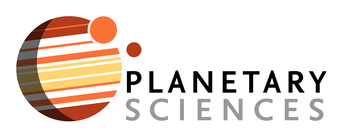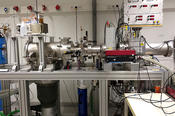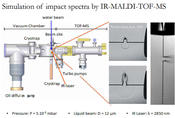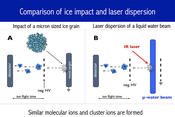Department of Earth Sciences
Service Navigation
Simulation of hypervelocity impacts of ice particles with laser dispersion
A crucial factor for on-going and future research projects are experiments that simulate hypervelocity impacts (velocities > 1km/s) onto space detectors. The basis for Time-of-Flight Mass Spectrometry (TOF-MS) of micron-sized dust particles in space is impact ionization. Upon impact, a substantial fraction of the dust particle is converted into elemental and molecular ions that can then be analyzed by mass spectrometry.
Contact
The laser-laboratory is situated on the GeoCampus
in Berlin-Lankwitz, building B, 2nd floor, room B238 (phone +49 30 838 70537).
Contact persons:
Dr. Jon Hillier (phone +49 30 838 70822)
Fabian Klenner (phone +49 30 838 66281)
Equipment
20Hz Nd:YAG (Neodymium-doped Yttrium
Aluminum Garnet) Laser
Reflectron Time-of-Flight Mass Spectrometer
Project Links
For quantitative interpretation of impact ionization spectra, analogue experiments in the lab are mandatory. For mineral and organic dust particles, this is achieved by electrostatic acceleration of micron and sub-micron sized dust grains of known composition that are fired upon duplicates of the space detectors. Our research group frequently participates in respective experiments carried out at accelerator facilities in Germany and the US.
Acceleration of icy particles to the desired speed is currently not possible. However, to simulate icy particle impact one can use a laser-driven analogue setup. Here a highly focused pulsed laser intersects a micron-sized water beam (or similar sized water droplets) of controlled composition to simulate an ice particle impact. The ions are then directed into a TOF-MS to record analogue spectra. In our lab in Berlin we run such a (worldwide unique) setup. It is currently in heavy use for the Cassini mission and will be needed for many years to come for the Europa Clipper and other future missions exploring subsurface oceans.
A 12-20 μm wide liquid jet of desired composition consists of an intact ≈3 mm long beam, which disintegrates into droplets further down. The tunable infrared laser beam is generated by pumping an Optical Parametric Oscillator (OPO) with a 20Hz Nd:YAG-laser. The laser acts onto the liquid like a mechanical hit, producing a cloud of charged and neutral molecules very similar to the impact cloud from hypervelocity ice grain impacts. A reflectron TOF-MS is used to sample an adjustable number of spectra after a predefined delay time. By setting a delaytime, we preselect ions dependent on their initial velocity. In the past years, we learned to adjust the intensity of the laser pulse and the delay time to mimic different impact speeds of ice grains onto mass spectrometers in space. The recorded spectra are digitized by an Analogue to Digital Converter (ADC) and visualized with a LabVIEW controlled computer.
Our analogue experiment is used exclusively for a systematic simulation of icy impact ionization spectra with varying impact energy and composition. For example from analogue mass spectra taken with this setup the high sodium salt content of some Enceladus' plume particles could be inferred. In addition to the chemical 'reconstruction' of ice grains detected by Cassini in the Saturnian system, the preparation for compositional analysis of ejecta from other icy worlds (i.e., Enceladus, Europa and other Galilean moons, or comets) are the main objectives. In October 2016, the setup was upgraded with a new bi-polar high-performance spectrometer. In the framework of our ERC project another substantial upgrade is planned by employing a UV laser for secondary ionization of neutral molecules, that abundantly form when the IR laser hits the water beam. This setup will then also be able to record cation and anion spectra simultaneously. In parallel, another advanced experiment is currently developed in collaboration with the Leibniz Institute of Surface Engineering in Leipzig (Prof. Bernd Abel). This new setup will be used as a generator of high-speed ice particles, accelerating sub-micron ice grains to speeds of 5 km/s or higher, which then are available for impact experiments.



